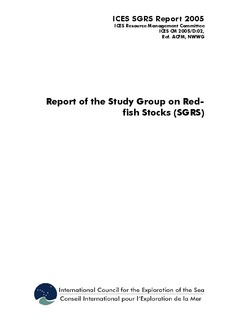| dc.description.abstract | 1. Review of the survey design of the international trawl- acoustic surveys in the Irminger Sea and adjacent waters. The methods of hydroacoustic and trawl estimation of abundance and biomass of pelagic redfish in the Irminger (and partly Labrador) Sea were reviewed under consideration of past experience, re-cent knowledge on the biology of the species and technological developments. Recommendations for the upcoming survey in June/July 2005 and for future work were developed by the Group. Especially the signal-to-noise ratios and tar-get strength models applied within the hydroacoustic measurements require fur-ther experimental work. The use of a lower transducer frequency (18 kHz) was also considered as a possibility for the estimation of redfish density below the “deep-scattering layer” (DSL).
2. Planning of the international trawl/acoustic survey of redfish in the Irminger Sea and adjacent waters in June/July 2005. Based on past experience and the suggested improvements that can already be implemented during the next survey in June/July 2005, the detailed survey plan for this survey was set up. Three ves-sels from Germany, Iceland and Russia will participate in the survey and operate within an area of around 400 000 NM2 in the Irminger and Labrador Sea to esti-mate the abundance and biomass of pelagic redfish. In the depth zone that can be surveyed by hydroacoustic measurements, i.e. shallower than the DSL (down to about 350 m), hydroacoustic measurements and identification trawls will be car-ried out, whereas within and below the DSL (down to about 1000 m), redfish abundance can currently only be estimated by trawls. The Group decided that the trawling duration of the deeper hauls will be expanded to at least 3 hours to in-crease the catch rates for a more precise abundance estimation. As in the past sur-veys, biological data will be collected from the redfish caught by the pelagic nets employed, and hydrographic measurements will be taken on regular stations on the survey tracks.
3. Required frequency, number of vessels needed and timing of future surveys. Although an annual survey would certainly allow an improved estimation of in-terannual changes in distribution and abundance, the Group felt that the continua-tion of bi-annual surveys would be more realistic, considering limitations in na-tional budgets for survey time. The Group recommends that at least four vessels should participate to allow a sufficiently dense coverage of the survey area. The efforts directed at involving other nations in the survey should be continued. Since the most recent survey in May-June 2003 was carried out about 3 weeks earlier than previous surveys and pointed to considerable seasonal effects, the Group recommends to keep the timing of the survey from (mid-)June to (mid- to late) July. | en |
